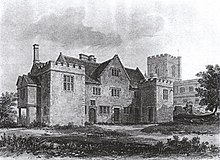William Edington
William Edington | |
|---|---|
Keeper of the wardrobe |
William Edington (died 6 or 7 October 1366) was an English bishop and administrator. He served as
Royal service
Edington's parents were Roger and Amice of

The King must have been impressed by Edington's performance, because in 1344 he made him treasurer of the realm, a position he held for the exceptionally long period of twelve years.[2] This was a job fraught with problems, as the nation was in serious financial difficulties by the mid-1340s. The treasury was in great debt from the heavy demands of the early stages of the Hundred Years' War. By then reneging on his debts, the king had lost public confidence, and struggled to obtain new loans. Edington saw the need to bring all royal expenditure under the oversight of the exchequer. This did not entail controlling the King's use of his resources – a move Edward would have resented greatly – but simply attempting to budget all revenues and expenses. By the early 1360s, this was largely achieved; a testimony to the capabilities and energy of Edington as an administrator.[2] In 1356, he was named chancellor, a post he held until his retirement from the national scene in 1363,[3] possibly for health reasons.
Ecclasiastical career
Edington also held ecclesiastical benefices. After his education at Oxford[contradictory] he held a succession of rectorates in Northamptonshire: first at Cottingham, then at Dallington, and finally from 1322 at Middleton Cheney.[4]
In 1335 Orleton collated Edington to the rectory of

The monks of Winchester had already elected one of their own number, but this was over-ruled, and Edington was consecrated in 1346. As a bishop, he was necessarily much absent, even with the relatively short distance between
Edington was the first Prelate of the Order of the Garter on its foundation in 1348, and that office has ever since been held by his successors as Bishops of Winchester.[6]
In May 1366, as a final sign of royal gratitude, King Edward had Edington elected Archbishop of Canterbury. Edington, however, declined on the grounds of failing health; or rather, he declined because, as he said, "Canterbury is the higher Rack, but Winchester is the better Manger," i.e., the former was the higher honour, but the second provided the higher income.[7] Five months later, on 6 or 7 October 1366, he died at Bishop's Waltham. He is buried in Winchester Cathedral, where his effigy can be seen in the chantry chapel he himself had built in the nave.
Citations
- ^ a b c Davies 2004
- ^ a b Ormrod 1990, pp. 88–9
- ISBN 0-521-56350-X.
- ^ Jackson, Canon JE (1882). "Edingdon Monastery". The Wiltshire Magazine. XX. Devizes: HF Bull: 244. Retrieved 10 February 2015.
- ^ "Victoria County History – Wiltshire – Vol 3 pp320-324 – House of Bonhommes: Edington". British History Online. University of London. Retrieved 21 November 2015.
- ^ Begent, P.J.; Chesshyre, H. (1999) The Most Noble Order of the Garter: 650 Years. London: Spink and Son. ISBN 1-902040-20-1.
- ^ Philip W. Sergeant (1899). "I. HISTORY OF THE CATHEDRAL". The Cathedral Church of WINCHESTER A Description of Its Fabric And A Brief History of The Episcopal See (2nd ed.). RIVERSIDE PRESS, EDINBURGH. Retrieved 23 July 2020.
Edingdon's attachment to Winchester is well illustrated by his quaint reason for refusing the offer of Canterbury: "if Canterbury is the higher rack, Winchester is the better manger."
References
- Davies, RG (2004). "Edington, William (d. 1366)". Oxford Dictionary of National Biography. required.) (paysite)
- Ormrod, WM (1990). The Reign of Edward III. New Haven & London: ISBN 0-300-04876-9.
Further reading
- ISBN 0-85683-125-5.
- Hockey, SF, ed. (1986). Register of William Edington, Bishop of Winchester, 1346–66. Hampshire Record Series. Vol. VII. ISBN 0-906680-04-2.
- Hockey, SF, ed. (1987). Register of William Edington, Bishop of Winchester, 1346–66. Hampshire Record Series. Vol. VIII. ISBN 0-906680-04-2.
- ISBN 0-19-821712-9.
- Stevenson, JH, ed. (1987). The Edington Cartulary. Vol. XLII. Wiltshire Record Society. ISBN 0-901333-19-0.


